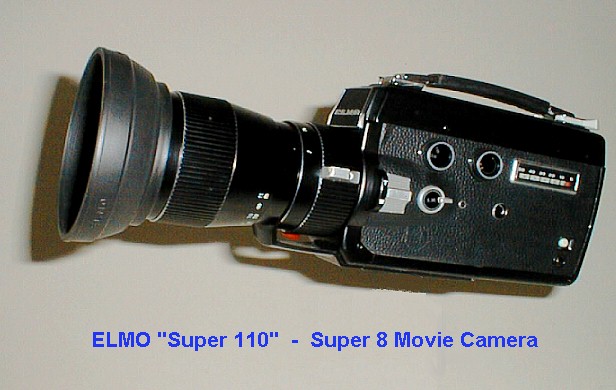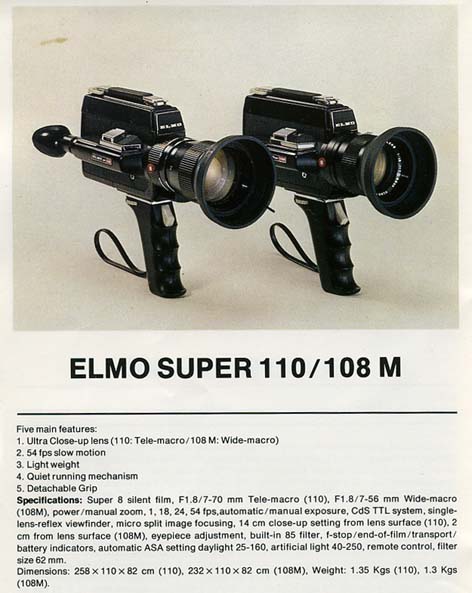Elmo Super 110
Elmo Super 110
Year: 1972-75
Weight: 1350 g
Lens: Elmo Zoom 1,8 / 7 - 70 mm, filter thread 62mm
Macro focusing to 14cm from lens
Split Image Focusing
Auto / Manual Zoom (Auto zoom: approx 7.5 sec from 70-7mm or 7-70mm)
Frame rates: 18, 24, 54 + single frame
Shutter degree: 160
Manual / Auto Exposure
ASA: daylight 25,40,64,100,160 tungsten 40, 64, 100, 160, 250
Remote control socket
Cable release socket
No sound
Batteries: 4 AA
Viewfinder: Adjustable from +3 to +1 diopter, displays end of film warning, Battery check, and current F stop
Made in Japan
Dimensions: approx. 25.8cm x 11cm x 8.2cm
Weight: approx. 1.35kg
Notes: Has window for film type, and rotating arrows to show film transport.
Original price in England (in the year of introduction): £210
Instruction manual: http://www.mondofoto.com/manuals/Elmo_110.zip

Contents
Comments[edit]
Even though the manual states that this camera has got a "slow-motion-speed" of 54fps, several users reported that "it's more like 52fps". This observation could be true since on some pages the manual is only talking about "approx. 54fps".
A nice side-story:
When the German manual was printed, the camera still needed an extra battery for the light-meter. In order not to dump those manuals, Elmo put large stickers onto page 6, stating that this camera doesn't need such an extra battery "due to the usage of ICs". Nevertheless Elmo forgot to remove the line "1 Quecksilberbatterie für Belichtungsmesser" on page 21.
A note to say that my experience has been the light meter is a bit jumpy and even when locked seems to move upon pressing the button for action. Must be due to the fact that Elmo never isolated the light meter circuit from the main power circuit. Otherwise, fabulous images if you can get over the dancing meter needle.
Reviews[edit]
by Jörg Polzfuß[edit]
When it comes to Elmo-projectors, e.g. the GS1200, nearly everyone would rate them as high-end devices - with all the features you need (and a lot more). But the opinions about Elmo-cameras differ alot: Nearly everyone agrees on the fact that their mechanics and optics are good. Unfortunately Elmo decided to make most of their cameras as compact, light-weight, easy-to-use and fail-proof as possible. This was archived by a good design, some miniaturisation - and by removing features. As a result most cameras lack the 24fps-speed, manual exposure, ... . Hence they were rated as great "home movies"-cameras in the 70s, but most nowadays amateur-filmmakers will only laugh about those "toy cams".
Luckily this camera is one of Elmo's best. Hence it has got the good optics, ... and all the features you would expect from a decent camera. This device looks and feels just right, its weight is well balanced and allows taking steady pictures. It's even able to handle a 64ASA-film correctly! The only points why I like my Nizo 4056 better:
- The Nizo can rewind the film (of course limited by the design of the super8-cartridge) and can do fades and dissolves. The Elmo can't rewind and there's only an optional external fader.
- The Nizo has got a smaller filter-thread and hence is better suited for attaching anamorphots.
Nevertheless this Elmo is one of the best cameras I own - and it has been one of the cheapest (only approx. 5 EUR some years ago)!
by NICO FILMS[edit]
Elmo S8 cameras does not have the best reputation when it comes to build quality. However the super series of cameras must not be confused with the newer plastic Elmo cameras. The Elmo super 110 may be old, but they are really well built. And the optics are just fantastic! I have used my 110 for years now, and haven`t had any troubles at all. In fact the pictures I get with this camera exceeds all my other S8 cameras. The lens on this camera just keeps amazing me. The fact that you can remove the handle completely from the camera body is great. Makes it a good camera for sturdy tripod mounting, or using rod supports and matte boxes. The only drawbacks are the lack of an electronic remote socket, and the camera will not read 500asa film on automatic.
By Geoval[edit]
Classic, top of the line, late 60’s Elmo Super 8. Vastly underrated Elmo f 1.8 / 7-70mm macro zoom that produces sharp, contrasty, nicely saturated colours. The rarer than hen’s teeth 110R model came with a sync sound socket for sophisticated double system sound, otherwise identical to the readily available 110. Unlike the plasticky later model Elmos, the Elmo Super line was all metal and built to last. Fit and finish is quite good but not quite on a par with the best European models. Unlike other noisy silent cameras of the era, a serviced Elmo Super 110 runs extremely smooth and quiet. The one glaring weakness of the Elmo Super series is the flimsy, removable pistol grip, which ironically is also one its greatest strengths. Remove the pistol grip from this compact, well-balanced Super 8 and you now have a good match for the Steadicam Jr. The one feature of the Elmo Super 100 series that has the greatest relevancy to filmmakers today who do their own telecine is the stock oversized film gate. It’s even wider than the oversized film gate on the Nikon R10 giving you near widescreen capabilities in a stock Super 8 camera. Underrated and undervalued.
Links[edit]
eBay Auctions[edit]
